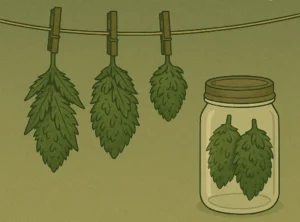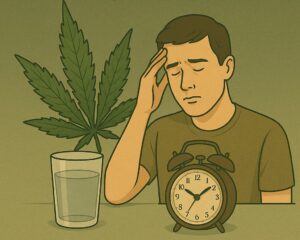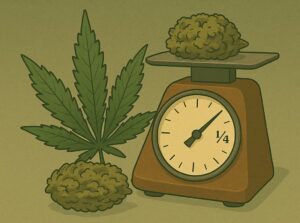If you’ve just finished harvesting, you’re probably wondering: How Long To Dry Buds Before Jarring? It’s a crucial step that can make or break the quality of your cannabis.
Drying isn’t just about removing moisture; it’s about preserving cannabinoids, protecting terpenes, and setting the stage for a smooth, flavorful cure. Rush it, and you risk mold or grassy-tasting buds. Take too long, and you lose potency and aroma.
In this guide, we’ll explore the ideal drying timeline, what signs to watch for, and the science behind why proper drying is essential before sealing your harvest in jars.
Why Proper Drying Before Jarring Is Essential
Drying isn’t just about reducing weight; it’s about preserving quality, stability, and safety.
- Mold and microbial risk: Wet or overly moist buds invite microbial growth. Ensuring moisture is lowered to safe levels before sealing in a jar is the guard against fungal contamination or spoilage.
- Terpene and cannabinoid preservation: Slower, controlled drying helps maintain aromatic terpenes and prevents decarboxylation or volatilization losses.
- Smoke quality: Properly dried buds break down chlorophyll and residual plant moisture. This leads to cleaner burning, smoother taste, and better consumer experience.
- Shelf life and stability: If the moisture is too high, humidity shifts inside a jar can cause rehydration or microbial spikes; if too low, the buds become brittle, lose aroma, and degrade faster.
In the cannabis industry, moisture content is typically targeted in the 6–15% range, with many aiming for 10–12% as a practical sweet spot. Anything higher than ~15% is often flagged for microbial contamination risk.
Thus, drying isn’t just a waiting game, but a controlled process to hit that moisture “sweet zone.”
Ideal Drying Duration: What Growers Commonly Use
In practice, most cultivators aim for 7 to 14 days of drying under ideal environmental conditions before jarring.
- Many “how-to” guides and commercial operations cite 7–10 days as a baseline under controlled 55–65 °F (13–18 °C) and 50-60% RH.
- Some growers stretch to 12–14 days when drying more slowly or in cooler, more humid climates.
- If conditions are less optimal (higher humidity, lower temp, dense buds), the drying can take 14+ days.
However, the clock isn’t everything: environment, bud density, cultivar, airflow, and maturity all influence this timeframe. A controlled drying setup and consistent monitoring enable you to hit the optimum point.
A recent study on controlled atmosphere drying for medicinal cannabis showed that when using optimized conditions, drying plus curing time could be reduced by at least 60% compared to more traditional methods, while better preserving volatile terpenes.
That means in some setups, you might shorten total time, but only if your parameters are tightly managed.
Environmental Guidelines: Temperature, Humidity & Airflow
The length of your drying window is intimately tied to the conditions you maintain. Here’s a breakdown of ideal ranges and why they matter:
If humidity is too high (> 60–65%), drying stalls, and mold risk increases steeply. If humidity is too low (< 40 %), buds can dry too fast—leading to brittle textures, terpene loss, or structural collapse.
Temperature matters too: at temperatures above ~70–80 °F, you risk accelerating terpene loss and chemical degradation.
In addition, vapor pressure difference (VPD) – the difference between internal bud moisture pressure and ambient air – plays a key role: if your environment doesn’t drive outward moisture escape, inner bud moisture lags and can cause internal mold or “wet core” issues.
So in short: maintain a stable, moderate drying environment and let the environment, not the calendar, dictate readiness.
Signs That Buds Are Ready for Jarring
Rather than slavishly sticking to a “day count,” learn to judge readiness by touch, sound, and visual cues. Here are the telltale signs:
- Snap test on stems: The smaller branch or the support stem should snap cleanly rather than bend. A soft bend indicates residual moisture.
- Exterior crisp, inner flex: Buds should feel somewhat crisp on the outside but not bone-dry; inside, they should retain a slight sponginess.
- Consistent dryness: No damp spots, clumping, or “cold” zones when you squeeze or feel between fingers.
- Aroma strength: The aroma should smell full, not grassy or “green.” A fresh, strain-specific scent is a good indicator of proper drying.
- Trichome and visual condition: Trichomes should look intact, not blown off or damaged. No visible signs of mold, discoloration, or moisture beads.
When these features align, you have a “go” to jar and begin the curing phase.
The Risks: Jarring Too Early vs. Drying Too Long
Jarring Too Early (Under-dried)
- Mold or mildew: Any residual moisture sealed in a jar can promote microbial growth, especially in dense buds.
- Uneven curing: Moisture may migrate later and cause “hot spots” or localized rehydration.
- Loss of control: You’ll have to burp jars frequently and may face batch losses.
Drying Too Long (Over-dried)
- Terpene volatilization & cannabinoid degradation: Extended exposure to air will drive off aromatic compounds and can degrade potency.
- Brittle, harsh product: Buds become crumbly, lose desirable texture, and smoke harshly.
- Weight loss: Over-drying cuts yield more than necessary by stripping volatile compounds and “overdry” matter.
- Diminished consumer appeal: Aroma, mouthfeel, and overall quality suffer.
In a well-managed drying environment, this “just right” window is quite achievable. That’s why the goal is to stop drying the moment buds are ready, not a moment earlier or later.
As a rough data point: hang-dry protocols often seek to remove 70–75% of initial moisture, leaving 10–12% moisture in the dried flower as a target.
Best Practices for Drying Before Jarring
Here are key tactics to ensure you hit that pivotal moment accurately:
- Controlled environment setup: Use climate control (dehumidifiers, HVAC, humidifiers) and multiple sensors (thermometers, hygrometers) to maintain target ranges.
- Gentle, even airflow: Air should move in the room but not blow directly onto buds. Aim for low-velocity circulation (1–2 ft/s or so) to avoid uneven drying.
- Hang vs. rack drying
- Hang drying whole branches or plants is traditional, simpler, and works well if space allows.
- Rack drying (on trays in a rack) gives more control and better airflow in tight spaces.
- Monitor often: Check daily for moisture gradients. Use simple tests (snap, feel) instead of relying solely on calendar days.
- Avoid direct light: Protect the drying area from light (especially UV) to preserve cannabinoids and terpenes.
- Patience over speed: Resist the temptation to ramp up temperature or force drying. Fast drying is often destructive to aromatic compounds.
- Consider cultivar specificity: As shown by a controlled-atmosphere drying study, different chemovars may respond better to tailored gas compositions (like N₂ or CO₂ mixes).
Transitioning Into the Cure Phase
Once your buds are at the right dryness level and ready to jar:
- Use airtight glass jars, filling to about 75% so air circulation is possible.
- Burp jars daily (open briefly) during the first week or two to release trapped moisture and prevent spike humidity.
- Target curing RH within jars at 58–65% (many aim ~60%).
- Store jars in cool, dark spots. Over weeks to months, the buds equilibrate internally, smooth out, and mature in flavor.
Curing is beyond this article’s scope, but the takeaway is: drying sets you up for successful, even curing.
Conclusion
Drying cannabis buds before jarring is more art than stopwatch.
While 7–14 days is a solid guideline under good conditions, the true determinant is when the buds pass the snap test, feel right, and carry strong aroma. Aim for 10–12% moisture, maintain stable environment (55–65 °F, 45–55% RH), gentle airflow, and darkness.
With controlled drying, you’ll minimize risks of mold or terpene loss, set yourself up for smooth curing, and deliver a higher-quality product for consumers.
Norcal Holistics is committed to delivering premium cannabis that’s carefully cultivated, dried, and cured to perfection.
Browse our menu today to explore lab-tested flower, edibles, vapes, and more, all available for safe, convenient Sacramento weed dispensary delivery.



